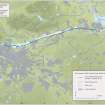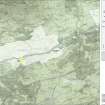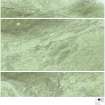Wilderness West, Antonine Wall
Enclosure (Roman), Frontier Defence (Roman)
Site Name Wilderness West, Antonine Wall
Classification Enclosure (Roman), Frontier Defence (Roman)
Alternative Name(s) Wilderness Plantation
Canmore ID 44483
Site Number NS57SE 19
NGR NS 5950 7206
Datum OSGB36 - NGR
Permalink http://canmore.org.uk/site/44483
- Council East Dunbartonshire
- Parish Cadder (Strathkelvin-du)
- Former Region Strathclyde
- Former District Strathkelvin
- Former County Lanarkshire
NS57SE 19 59500 72089
(NS 595 720) A crop mark enclosure at Buchley is one of a group of three (see also NS57SE 21 and NS67SW 29) identified in the same sector of the Antonine Wall on air photographs by the RAF (CPE/Scot/UK276/ 5151-2) J K St Joseph (CUCAP U53, 55-6, V81) and RCAHMS.
Excavation in 1980 revealed a banked and ditched sub-rectangular enclosure abutting the south side of the Wall and clearly post dating its construction. Vestiges of an internal bank not more than 2.5m wide reduced an internal area from 11.5m by 8.2m to approximately 6m square. The interior, which sloped down to the back of the Antonine rampart, had been levelled with layers of earth and turf, but no trace of a timber structure or occupation floor was found. The function of the enclosure is uncertain, but neither of the likely explanations - Watch Tower, or Beacon Stance - can be supported on the evidence found, and it seems unlikely that it was envisaged as a temporary work. Finds comprised a few fragments of black burnished ware.
W S Hanson and G S Maxwell 1981.
NS 5950 7206 There is no surface trace of the enclosure or the Antonine Wall in a level, arable, field. Neither are there surface indications of the recent excavation. Grid Reference postulated from air photograph evidence.
Visited by OS (J R L) 27 May 1981.
Listed. No additional information.
RCAHMS 1982.
Excavation (September 1980)
NS57SE 19 59500 72089
Excavation in 1980 revealed a banked and ditched sub-rectangular enclosure abutting the south side of the Wall and clearly post dating its construction. Vestiges of an internal bank not more than 2.5m wide reduced an internal area from 11.5m by 8.2m to approximately 6m square. The interior, which sloped down to the back of the Antonine rampart, had been levelled with layers of earth and turf, but no trace of a timber structure or occupation floor was found. The function of the enclosure is uncertain, but neither of the likely explanations - Watch Tower, or Beacon Stance - can be supported on the evidence found, and it seems unlikely that it was envisaged as a temporary work. Finds comprised a few fragments of black burnished ware.
W S Hanson and G S Maxwell 1981.
Field Visit (27 May 1981)
NS 5950 7206 There is no surface trace of the enclosure or the Antonine Wall in a level, arable, field. Neither are there surface indications of the recent excavation. Grid Reference postulated from air photograph evidence.
Visited by OS (J R L) 27 May 1981.
Aerial Photography (1981)
(NS 595 720) A crop mark enclosure at Buchley is one of a group of three (see also NS57SE 21 and NS67SW 29) identified in the same sector of the Antonine Wall on air photographs by the RAF (CPE/Scot/UK276/ 5151-2) J K St Joseph (CUCAP U53, 55-6, V81) and RCAHMS.
Note (1982)
Wilderness Plantation, Enclosures NS 592 719, 595 720, 600 721 NS57SW NS67SW
In the sector of the Antonine Wall N of Wilderness Plantation three sub-rectangular enclosures abutting the S face of the Rampart have been identified from cropmarks. The eastermost, situated 260m E of the Wilderness Plantation fortlet (NS57SE 11), has been destroyed; the other two lie 285m and 580m respectively W of the fortlet. They appear to have been almost identical in size, and excavation of the central one shows that it measured about 6m square within a bank with external ditch, and belonged to the primary phase of the Wall. Its purpose is uncertain, but it is unlikely to have been a turret or beacon-stance.
RCAHMS 1982
(RCAHMS 1978, pp. 113, 159, No. 247; DES, 1980, 82.)
Publication Account (2008)
A 1:25000 scale map of the Antonine Wall was published by RCAHMS in 2008. The map shows the course of the Antonine Wall on a modern map base, including areas where the Wall is in public ownership or care and can be visited. The data had been collated as part of the project to prepare maps for the World Heritage Site nomination bid.




























